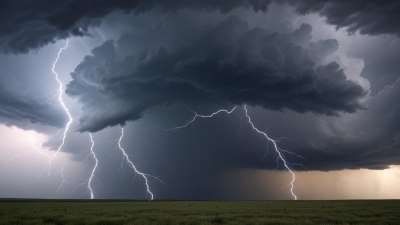Why Some Ice Storms Are Silent Killers
Discover the hidden dangers of ice storms and how they can become silent killers, impacting lives and environments.

Ice storms are among the most dangerous weather events, often striking without much warning. While many extreme weather phenomena are accompanied by loud, dramatic effects, ice storms can be eerily silent yet incredibly deadly. This article delves into the reasons why some ice storms are considered silent killers and the impact they can have on communities and individuals alike.
What Is an Ice Storm?
An ice storm occurs when freezing rain falls, coating surfaces in a layer of ice. For a weather event to be classified as an ice storm, the amount of accumulation must typically be at least 0.25 inches. This seemingly innocuous precipitation can lead to serious consequences, including power outages, property damage, and even loss of life.
The Formation of Ice Storms
Understanding how ice storms form helps illuminate why they can be deadly. Ice storms usually occur when warm moist air rises over a colder air mass. As the warm air rises, precipitation forms as rain. However, as this rain falls through a layer of cold air near the surface, it freezes upon contact with anything colder than 32 degrees Fahrenheit, creating a slick layer of ice.
Why They Are Silent Killers
Many people underestimate the dangers posed by ice storms due to their quiet nature. Unlike thunderstorms or tornadoes, which produce loud, alarming sounds, ice storms can creep in silently. There are several reasons why ice storms can become silent killers:
1. Lack of Immediate Danger Signals
People often receive alerts for severe thunderstorms or tornadoes via sirens or notifications. Ice storms may not elicit the same urgency in weather broadcasting systems, leading to a false sense of security among residents.
2. Gradual Onset of Conditions
Ice storms often develop gradually over hours, leading people to underestimate their severity. As the freezing rain accumulates, the situation can quickly become hazardous. Roads and walkways may look normal initially, but treacherous ice can develop invisibly beneath the surface.
3. Power Outages and Infrastructure Damage
The weight of ice accumulation can bring down trees and power lines. Once the ice begins to weigh heavily on branches, the risk of falling limbs increases dramatically. These unexpected events can lead to hazardous situations, particularly in urban areas where infrastructure is older and less resilient.
4. Increased Accident Rates
As roads become icy, driving conditions deteriorate, and accidents become more likely. According to the National Highway Traffic Safety Administration, icy roads contribute to thousands of accidents every year. The days immediately following an ice storm are particularly dangerous as the public may attempt to resume normal activities too soon.
5. Isolation of Communities
Ice storms can isolate communities as roads become impassable and power outages leave people without heat or food. In rural areas, this isolation can become life-threatening, particularly for vulnerable populations, such as the elderly.
Preparedness Strategies
Being prepared for an ice storm is essential to minimize risks. Here are several strategies that individuals and communities can implement:
1. Stay Informed
Constantly monitor weather reports and pay attention to alerts regarding ice storms. Technology has advanced substantially, and real-time weather apps can provide up-to-minute warnings.
2. Prepare an Emergency Kit
Having a well-stocked emergency kit can make a significant difference in a power outage. Items should include non-perishable food, bottled water, flashlights, batteries, and a first-aid kit.
3. Winter-Proof Your Home
Before the winter storm season, invest in equipment such as a generator, space heaters, or additional insulation to keep homes warm and functional during an outage.
4. Avoid Travel
During predicted ice storms, it is always advisable to avoid unnecessary travel. If travel is absolutely essential, ensure the vehicle is winter-ready with snow tires and an emergency kit.
5. Understand Risk Factors
Families with members who are elderly or have health concerns should have a plan that includes finding shelter or immediate assistance should an ice storm occur. Check on neighbors and those who may be vulnerable during these times.
Real-Life Ice Storm Case Studies
Over the years, several ice storms have illustrated the potentially devastating effects of freezing rain. Here are notable examples:
1. The 1998 Ice Storm in Quebec
This devastating ice storm lasted for a week from January 5-9, impacting millions. Accumulations of ice reached over 100 mm (approximately four inches) in some areas. The effects were catastrophic—power outages lasted weeks, and communities struggled to recover. Losses associated with this storm exceeded $5 billion.
2. The 2009 Ice Storm
Another notable storm hit the Southern United States in December 2009. States like Arkansas, Kentucky, and Tennessee saw extensive power outages and traffic accidents due to ice accumulation. The economic impact was significant, particularly for local businesses that were inaccessible during this time.
3. The 2014 Ice Storm in the Midwest
This storm brought ice to areas including Ohio and Indiana, resulting in hazardous driving conditions and power outages affecting over a million residents. The storm’s quiet nature caught many off guard, proving that these storms can arrive with little warning.
Ice storms may seem less dramatic than thunderstorms or snowstorms, but their potential to cause harm is significant. These silent killers can wreak havoc on communities and lives, often without any warning. By understanding their formation, preparation strategies, and real-life consequences, individuals can be better equipped to face these increasingly prevalent weather phenomena. Communities must prioritize awareness and preparedness to ensure they are ready for whatever winter may bring.











